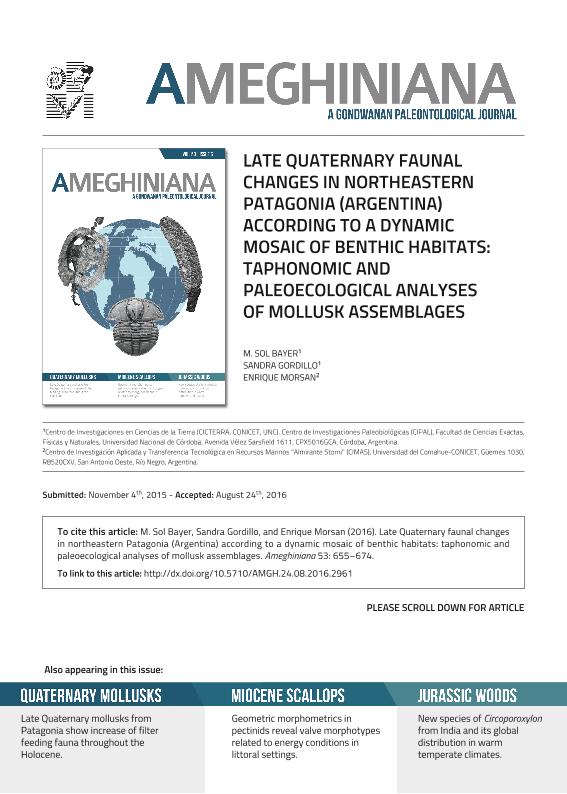Artículo
The aim of this study is to describe and interpret the paleoenvironmental history of the San Matías Gulf (SMG), in northern Patagonia, Argentina, which is associated with possible biotic and abiotic changes that occurred during the late Quaternary. In this regard, a taphonomic (disarticulation, right/ left valve ratio, fragmentation, abrasion, teeth preservation) and paleo ecologic (alpha diversity, species abundance, life habit,<br />substrate preference, feeding mode) analysis of Amiantis purputata (the target species) and its accompanying faunal remains (the non-target species) in modern, Holocene and Pleistocene shell assemblages, was performed. The general trend of the SMG throughout the late Quaternary was that of a low energy environment with varying water energy intensity depending on the study area. Additionally, each study site contains<br />different substrates marked by patches of sand and rock which would have also determined the presence of certain species and, in turn, the proportion of sandy and rocky patches may have changed over time thus leading to the development of different local paleocommunities. Therefore, this gulf presents a dynamic mosaic of environments over time. Its waters would have been sufficiently rich in nutrients to allow the<br />development of the filter feeding fauna which dominated the late Quaternary, especially A. purpurata. Crepidula species, which feed in two distinct ways (herbivore and filter feeding), increased in proportion throughout the Holocene. These changes, among others, coincided with the Last Glacial Maximum, the final configuration of the SMG, the Climatic Optimum of the Holocene and the impact of humans in the area. El objetivo de este estudio fue describir e interpretar la historia paleoambiental del Golfo San Matías (GSM), noreste de Patagonia, Argentina, asociada a posibles cambios bióticos y abióticos producidos durante el Cuaternario tardío. Para ello se realizaron análisis tafonómicos (desarticulación, relación valva derecha/ izquierda, fragmentación, abrasión, preservación de los dientes) y paleoecológicos (diversidad alfa, abundancia de especies, hábito de vida, preferencia de sustrato, modo de alimentación) en valvas de Amiantis purputata (target taxa) y su fauna acompañante provenientes de ensambles actuales, del Holoceno y Pleistoceno. La tendencia general del GSM a lo largo del Cuaternario tardío corresponde a un ambiente de baja energía, con mayor o menor intensidad en función del sitio de estudio. Además, cada sitio de estudio contiene diferentes sustratos que muestran parches de arena y rocas, lo que habría determinado la presencia de ciertas especies; a su vez, la proporción de los parches de arena y rocas pudo haber variado en el tiempo dando lugar al desarrollo de diferentes paleocomunidades locales. Por lo tanto, este golfo presenta un mosaico dinámico de ambientes a lo largo del tiempo. Sus aguas habrían sido lo suficientemente ricas en nutrientes permitiendo el desarrollo de la fauna filtradora que dominó en el Cuaternario tardío, especialmente A. purpurata y Crepidula spp. de doble alimentación (herbivoros y filtradores) que incrementaron su proporción a lo largo del Holoceno. Estos cambios, entre otros, coincidieron con el Último Máximo Glacial, la configuración final del GSM, el Óptimo Climático del Holoceno y el impacto antrópico en el área.
Late quaternary faunal changes in Northeastern Patagonia (Argentina) according to a dynamic mosaic of Benthic Habitats: Taphonomic and paleoecological analyses of mollusk assemblages
Fecha de publicación:
12/2016
Editorial:
Asociacion Paleontologica Argentina
Revista:
Ameghiniana
ISSN:
0002-7014
e-ISSN:
1851-8044
Idioma:
Inglés
Tipo de recurso:
Artículo publicado
Clasificación temática:
Resumen
Palabras clave:
Taphonomy
,
Paleoecology
,
Dynamic Mosaic
,
Mollusks
Archivos asociados
Licencia
Identificadores
Colecciones
Articulos(CICTERRA)
Articulos de CENTRO DE INVEST.EN CS.DE LA TIERRA
Articulos de CENTRO DE INVEST.EN CS.DE LA TIERRA
Citación
Bayer, María Sol; Gordillo, Sandra; Morsan, Enrique Mario; Late quaternary faunal changes in Northeastern Patagonia (Argentina) according to a dynamic mosaic of Benthic Habitats: Taphonomic and paleoecological analyses of mollusk assemblages; Asociacion Paleontologica Argentina; Ameghiniana; 53; 6; 12-2016; 655-674
Compartir
Altmétricas




